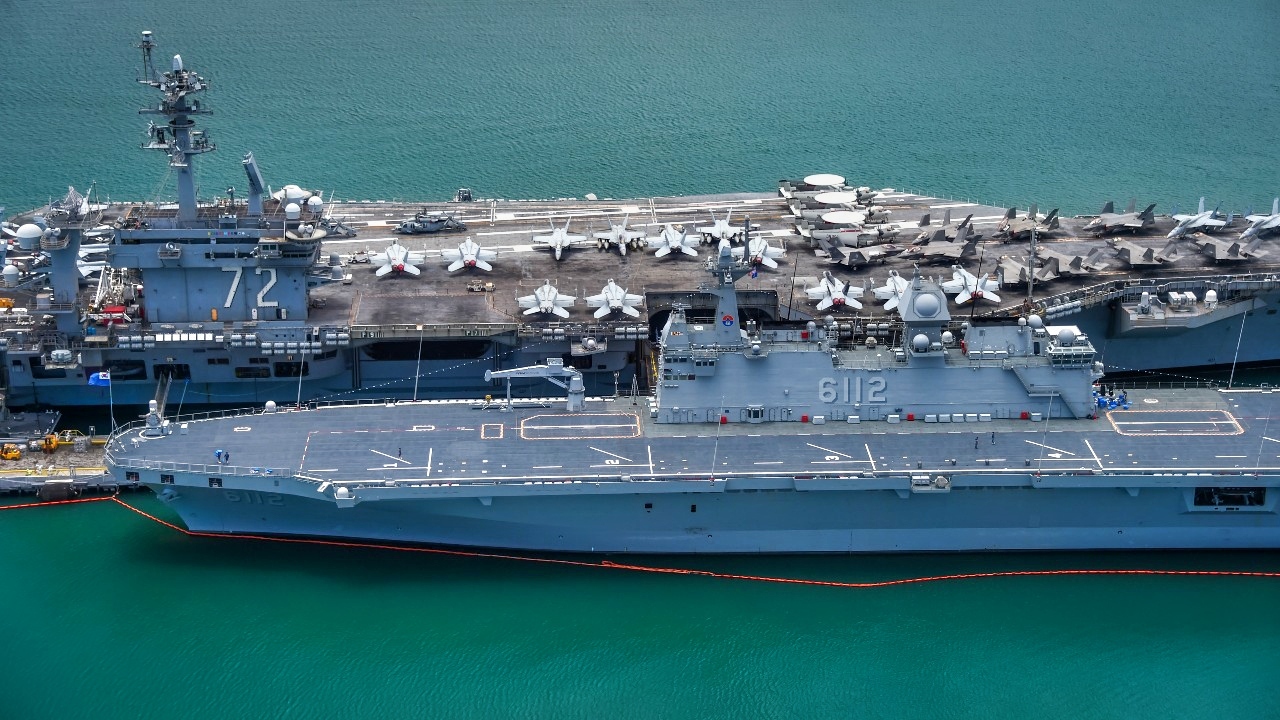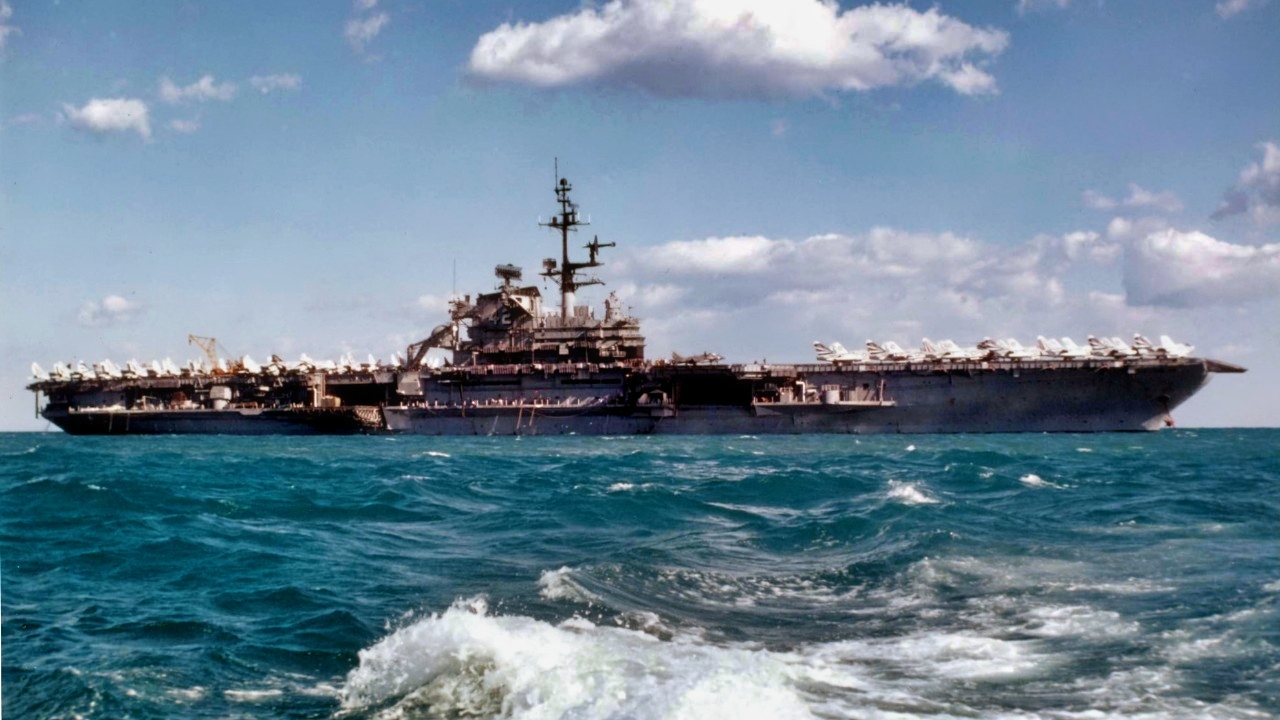Key Points and Summary – While it’s a common question, it is extremely unlikely for a modern aircraft carrier to capsize in a storm.
-Carriers are engineered to be inherently stable; their center of buoyancy is higher than their center of gravity, which creates a powerful righting force that grows stronger the farther the ship tilts.
-This design, combined with wide hulls, ballast systems, and numerous watertight compartments, makes them incredibly resilient.
-Historically, while carriers like the USS Monterey have been severely damaged by typhoons, the only carriers to ever capsize (like the USS Hornet) did so after suffering catastrophic combat damage, not from weather.
Could An Aircraft Carrier Capsize in a Storm?
There are few machines in the world designed better than aircraft carriers. These ships are marvels of mechanical engineering that are designed to withstand nearly any natural disaster at sea.

(Aug. 8, 2017) The Nimitz-class aircraft carrier USS George H. W. Bush (CVN 77) at sea during exercise Saxon Warrior 2017, Aug. 8. Saxon Warrior is a United States and United Kingdom co-hosted carrier strike group exercise that demonstrates allied interoperability and capability to respond to crises and deter potential threats. (U.S. Navy photo by Mass Communication Specialist 1st Class Theron J. Godbold /Released)
Many people wonder if a carrier would capsize in a major storm. To the civilian observer, the big supercarriers seem top-heavy; but the reality is far different.
An aircraft carrier could, in theory, capsize in a storm—because you can never underestimate the power of the sea. But it is extremely unlikely.
The Supercarrier Is Extremely Stable
Buoyancy is the property of being less dense than water. A carrier’s center of buoyancy is higher than its center of gravity. While many of the ship’s individual components, such as the steel deck plating, are far more dense than water and would sink on their own, when all parts are joined they combine to form the many hollow spaces inside a ship that allow it to float.

(July 7, 2022) – U.S. Navy nuclear-powered aircraft carrier USS Abraham Lincoln (CVN72) and Republic of Korea Navy amphibious assault ship ROKS Marado (LPH 6112) moored at Joint Base Pearl Harbor-Hickham, Hawaii, during Rim of the Pacific (RIMPAC) 2022. Twenty-six nations, 38 ships, four submarines, more than 170 aircraft and 25,000 personnel are participating in RIMPAC from June 29 to Aug 4 in and around Hawaiian Islands and Southern California. The world’s largest international maritime exercise, RIMPAC provides a unique training opportunity while fostering and sustaining cooperative relationships among participants critical to ensuring the safety of sea lanes and security on the world’s oceans. RIMPAC 2022 is the 28th exercise in the series that began in 1971. (U.S. Navy photo by Mass Communication Specialist Seaman Leon Vonguyen)
Carriers are designed so that all of this buoyant force is concentrated at a point higher than its center of gravity, or the concentration of its weight.
As Maya Carlin points out, once “a carrier begins to tip over, its center of gravity must rise father and father out of the water, requiring more and more force to continue doing so. This principle means the ship actually strives harder to right itself the farther it tips. In spite of any strange shapes or angles, carriers adhere to this principle, and it makes them inherently stable.”
What Kind of Damage Could Carriers Suffer In a Major Storm
While carriers won’t capsize, they can sustain damage in severe storms. Especially sensitive parts of the ship include the flight deck, antennas, and any unsecured aircraft or equipment. Waves can come over the flight deck, and loose equipment can cause damage and injury to the crew.
A “free surface effect” occurs when a large amount of free-flowing liquid on the hangar deck—such as water sprayed to fight a major fire—gives the ship a significant list.
A major accident, such as a loss of propulsion or steering while a ship is caught in a powerful storm, could leave it helpless and vulnerable to being battered by waves. This happened to the USS Monterey (CVL-26) during Typhoon Cobra in 1944.

(Oct. 30, 2007) – USS Ronald Reagan (CVN 76) conducts rudder checks as part of the ship’s Board of Inspection and Survey (INSURV) following a six-month Planned Incremental Availability. All naval vessels are periodically inspected by INSURV to check their material condition and battle readiness. U.S. Navy photo by Mass Communication Specialist 2nd Class M. Jeremie Yoder (RELEASED)
The Monterey survived the devastating typhoon in December 1944, but it sustained severe damage. During the storm, which was nicknamed “Halsey’s Typhoon,” the light aircraft carrier’s crew battled high winds and violent rolls that caused fires, washed away aircraft, and led to a loss of steering.
Future U.S. President Gerald Ford was on board and played a key role in fighting the fires, which resulted in the deaths of three sailors and injuries to many others.
Factors That Keep Carriers From Capsizing in Storms
Because a carrier’s center of buoyancy (where the buoyant force is concentrated) is higher than the center of gravity (where the weight is concentrated), the center of gravity shifts as the ship tips. The resulting force works to right the ship, making it more stable the farther it tilts.
The hull is engineered to be very wide and flat beneath the waterline, creating a stable platform that resists tipping. A V-shaped hull is also used to cut through large waves and reduce drag, while a pronounced flare below the waterline helps to deflect water and enhance stability.
Carriers use ballast systems to control their buoyancy and stability, helping them maintain a level trim even in rough seas.

The world’s largest aircraft carrier USS Gerald R. Ford (CVN) 78 and the USNS Laramie (T-AO-203) conduct a refueling-at-sea in the Eastern Mediterranean Sea, Oct. 11, 2023. USS Gerald R. Ford is the Navy’s newest and most advanced aircraft carrier, representing a generational leap in the U.S. Navy’s capacity to project power on a global scale. The Gerald R. Ford Carrier Strike Group is currently operating in the Eastern Mediterranean Sea, at direction of the Secretary of Defense. The U.S. maintains forward deployed ready and postured forces to deter aggression and support security and stability around the world.(U.S. Navy photo by Mass Communication Specialist 2nd Class Jackson Adkins)
Carriers are built with a vast number of watertight compartments and a reinforced steel structure, allowing them to withstand significant damage without sinking.
Today’s Aircraft Carrier Strike Groups Practice Excellent Weather Avoidance
Aircraft carriers and their Carrier Strike Groups have advanced radar and communication systems to track and avoid major storms long before they pose a threat.
They are also capable of high speeds, which allows them to outrun or maneuver around many storm systems.
Has An Aircraft Carrier Ever Capsized?
A carrier has capsized, but not due to a storm or other weather-related event. The USS Hornet (CV-8) was sunk in the Battle of the Santa Cruz Islands in October 1942, capsizing and sinking after being hit by Japanese torpedoes and bombs.
Within ten minutes, the Hornet was hit by four bombs and two torpedoes, and sustained significant damage from two dive bombers that crashed into her. Hornet lost her propulsion capability and was dead in the water.

Midway-Class Aircraft Carrier. Image Credit: Creative Commons.
After most of the crew was transferred from the ship, a damage control party put out the fires and repaired some of the damage. Later that afternoon, she was attacked again and hit by another torpedo and two bombs.
In July, 1945, the Japanese aircraft carrier Amagi capsized and sank after airstrikes conducted against her. The Amagi sank in Kure Bay, and was later refloated in 1946 and scrapped.
About the Author: Steve Balestrieri
Steve Balestrieri is a National Security Columnist. He served as a US Army Special Forces NCO and Warrant Officer. In addition to writing on defense, he covers the NFL for PatsFans.com and is a member of the Pro Football Writers of America (PFWA). His work was regularly featured in other military publications.
More Military
Nimitz-Class Aircraft Carrier USS Carl Vinson Has a Message for the U.S. Navy
The Navy’s New DDG(X) Destroyer Looks Like a Missile and Laser Machine
Germany’s Big F-35 Fighter Purchase Comes Down to 1 Word
Eurofighter Typhoon vs. JAS 39 Gripen E: Who Wins Summed up in 4 Words
JAS 39 Gripen E vs. Dassault Rafale Fighter: Who Wins in a Fight Summed Up in 4 Words










